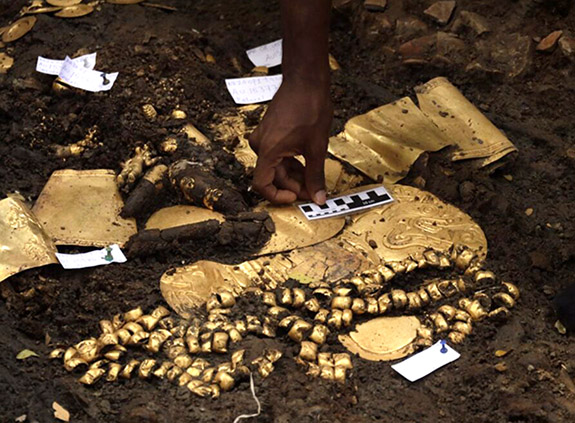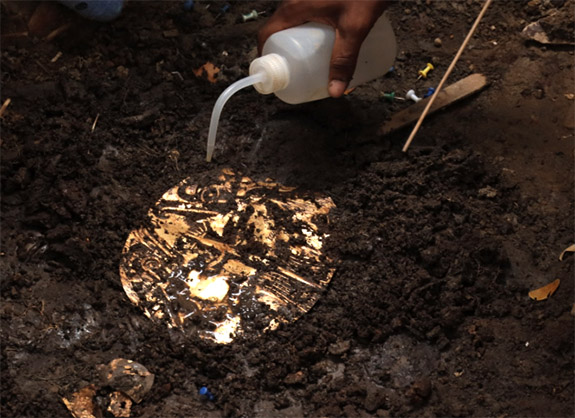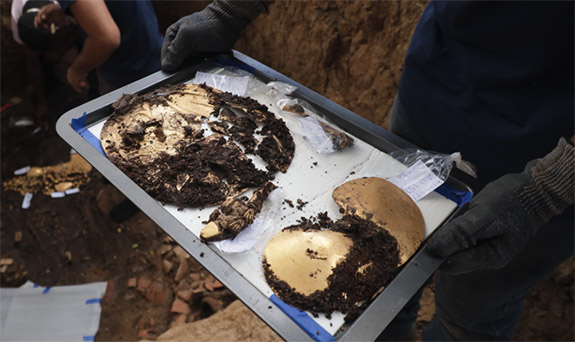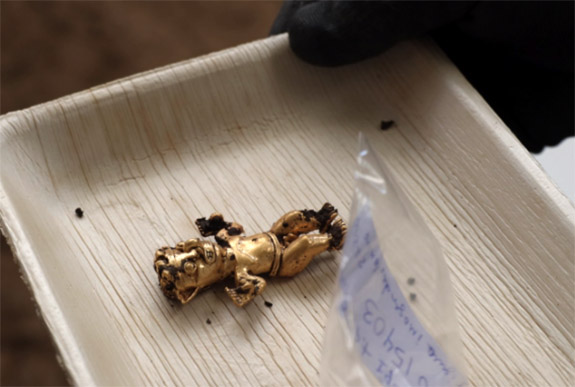Panamanian Archeologists Recover Golden Treasures From 1,200-Year-Old Tomb
Panamanian archaeologists have recovered a trove of golden treasures from the 1,200-year-old tomb of a powerful chief at El Caño, an ancient necropolis about 110 miles southwest of Panama City in Coclé province.

Among the artifacts discovered in the tomb were gold breastplates, gold bracelets, gold belts adorned with gold beads, gold-clad whale teeth earrings, a set of gold plates and gold earrings in the likenesses of a man, woman and crocodile.

Also in the funerary trousseau were two bells, skirts made with dog teeth and a set of bone flutes.
A more disturbing finding was that the tomb held as many as 32 other occupants, who were likely sacrificed to accompany the powerful leader to the "beyond." The archaeologists said the chief was buried face-down, as was the custom of that society, but are unsure of the exact number of those who joined him because the excavation has yet to be completed.

Dr. Julia Mayo, the director of the El Caño Foundation, believes the tomb was constructed in 750 AD and that the gold items belonged to a high-status adult male from the Rio chiefdom who died in his 30s.
She added that the recovered items possess not only economic value, but also "incalculable historical and cultural value."

In ancient times, El Caño was considered a city of the dead. The necropolis was built circa 700 AD and abandoned circa 1000 AD, according to the researchers. In addition to monoliths, the site contained a cemetery and a ceremonial area with wooden buildings.
Mayo said the findings are significant because they shed new light on "multiple" or "simultaneous burials" of the Coclé society, which included a high-status person, as well as eight to 32 others, who were sacrificed to serve as companions in the afterlife.
Credit: Images courtesy of Ciudad del Saber/Panama Culture Ministry.

Among the artifacts discovered in the tomb were gold breastplates, gold bracelets, gold belts adorned with gold beads, gold-clad whale teeth earrings, a set of gold plates and gold earrings in the likenesses of a man, woman and crocodile.

Also in the funerary trousseau were two bells, skirts made with dog teeth and a set of bone flutes.
A more disturbing finding was that the tomb held as many as 32 other occupants, who were likely sacrificed to accompany the powerful leader to the "beyond." The archaeologists said the chief was buried face-down, as was the custom of that society, but are unsure of the exact number of those who joined him because the excavation has yet to be completed.

Dr. Julia Mayo, the director of the El Caño Foundation, believes the tomb was constructed in 750 AD and that the gold items belonged to a high-status adult male from the Rio chiefdom who died in his 30s.
She added that the recovered items possess not only economic value, but also "incalculable historical and cultural value."

In ancient times, El Caño was considered a city of the dead. The necropolis was built circa 700 AD and abandoned circa 1000 AD, according to the researchers. In addition to monoliths, the site contained a cemetery and a ceremonial area with wooden buildings.
Mayo said the findings are significant because they shed new light on "multiple" or "simultaneous burials" of the Coclé society, which included a high-status person, as well as eight to 32 others, who were sacrificed to serve as companions in the afterlife.
Credit: Images courtesy of Ciudad del Saber/Panama Culture Ministry.

